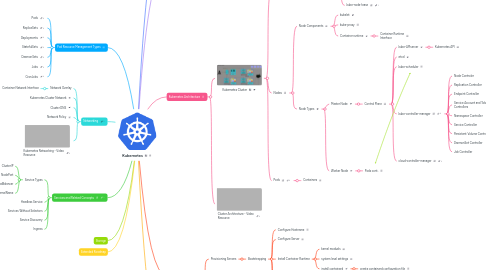
1. Pod Resource Management Types
1.1. Pods
1.2. ReplicaSets
1.3. Deployments
1.4. StatefulSets
1.5. DaemonSets
1.6. Jobs
1.7. CronJobs
2. Networking
2.1. Network Overlay
2.1.1. Container Network Interface
2.2. Kubernetes Cluster Network
2.3. Cluster DNS
2.4. Network Policy
2.5. Kubernetes Networking - Video Resource
3. Services and Related Concepts
3.1. Service Types
3.1.1. ClusterIP
3.1.2. NodePort
3.1.3. LoadBalancer
3.1.4. ExternalName
3.2. Headless Service
3.3. Services Without Selectors
3.4. Service Discovery
3.5. Ingress
4. Storage
5. Extended Roadmap
6. Kubernetes Concepts (Table of contents)
6.1. Kubernetes Overview
6.2. Kubernetes Architecture
6.3. Building A Cluster
6.4. Kubernetes Objects
6.5. Pod Resource Management Types
6.6. Networking
6.7. Storage
6.8. Security
6.9. Extended Roadmap
7. Overview
8. Kubernetes Architecture
8.1. Kubernetes Cluster
8.1.1. Namespaces
8.1.1.1. Initial Namespace
8.1.1.1.1. default
8.1.1.1.2. kube-system
8.1.1.1.3. kube-public
8.1.1.1.4. kube-node-lease
8.1.2. Nodes
8.1.2.1. Node Components
8.1.2.1.1. kubelet
8.1.2.1.2. kube-proxy
8.1.2.1.3. Container runtime
8.1.2.2. Node Types
8.1.2.2.1. Master Node
8.1.2.2.2. Worker Node
8.1.3. Pods
8.1.3.1. Containers
8.2. Cluster Architecture - Video Resource
9. Building A Cluster
9.1. Provisioning Servers
9.1.1. Bootstrapping
9.1.1.1. Configure Hostname
9.1.1.2. Configure Server
9.1.1.3. Install Container Runtime
9.1.1.3.1. kernel moduels
9.1.1.3.2. system level settings
9.1.1.3.3. install containerd
9.1.1.4. Install Kubernetes packages
9.1.1.4.1. install http and curl
9.1.1.5. initialize cluster
9.1.1.5.1. setup networking
9.2. Building a Cluster Video Resource
9.2.1. Kubeadm
10. Kubernetes Objects (AKA Resources)
10.1. Declarative Nature
10.2. Understanding Objects
10.2.1. Building Blocks
10.2.2. Object Types
10.3. Creation and Management
10.3.1. Manifest Files
10.3.1.1. YAML definition
10.3.1.2. Properties and Configurations
10.3.2. Creating Objects
10.3.3. Applying Manifest Files
10.3.3.1. kubectl
